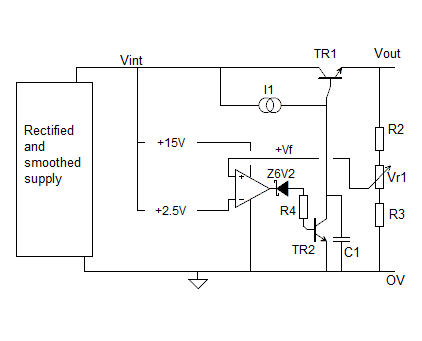John Errington's tutorial on Power Supply Design
Voltage regulation: a precision circuit
Our final design includes ideas from the previous design, with a more accurate (and lower voltage) voltage reference, and using an operational amplifier to increase the voltage gain in the feedback circuit.
To maintain excellent regulation at the load feedback connections are provided to allow connection at the load itself. This compensates for the resistance of the connecting wires (see feedback). The feedback connections will be connected to the Vout and 0V terminals at the load.
Full circuit diagram
 In this circuit TR1 is biased with a constant current provided by the LM317 regulator and R1.
In this circuit TR1 is biased with a constant current provided by the LM317 regulator and R1.
A second regulator (L7815) provides a constant +15V to the voltage regulator (AD580) and the LM318 op amp.
For details of operation consider the simplified circuit shown below.
Simplified circuit
 A current source feeds current to the base of TR1, allowing current to flow in the load and feedback divider chain.
A current source feeds current to the base of TR1, allowing current to flow in the load and feedback divider chain.
When the voltage Vf from the divider chain exceeds +2.5V the output from the op amp rises, allowing current to flow through TR2 base, and reducing the drive current to TR1 so as to maintain the output voltage at the set value.
The combination of zener and resistor R4 allow the op amp to operate from a single positive supply, reducing circuit complexity, component count - and cost.
C1 prevents oscillation and reduces the output resistance at high frequencies.
Component values and limitations of circuit
The L7815 has Vin Max = 35V and the LM317 has max Vin - Vout = 40V. If necessary higher voltages can be accommodated by adding an additional series regulator (see High voltages)
TR1 could be a BD645 or similar (Vceo = 60V) and TR2 an MJE340 or similar
The main limitation of this circuit is that using a potentiometer introduces a moving part which is subject to degredation through wear. For more accurate results a fixed resistor chain should be used. Alternatively if a programmable (in steps) output voltage is required an MDAC (multiplying digital to analog converter) can be substituted, allowing control of the output voltage from a computer or switch asssembly.
